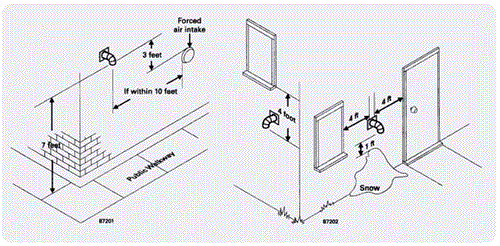The Department of Energy (DOE) has put the squeeze on manufacturers to design boilers with higher and higher efficiencies, which hasn’t necessarily been good from a venting aspect. Hot air rises, and the hotter the air, the better it rises. Many years ago, boilers weren’t very efficient and a lot of the heat went into the chimney, which meant the chimney heated up nicely and proper venting occurred.
Today, things are different. Higher-efficiency boilers mean that not as much heat goes up the chimney, so the chimney may not warm up enough and proper venting may not occur. It’s up to contractors to make sure the system is set up to vent properly, whether that means installing a liner in the chimney or providing for sidewall venting.

Check Out the Chimney
There have been stories on the news lately about improper venting; and indeed, people have died in homes where appliances weren’t vented correctly. That’s why it’s so important for contractors to look closely at the boiler to make sure proper venting is taking place.Of course it’s necessary to read manufacturer literature for each boiler to check for proper venting on that particular boiler. And it’s just as important to know your codes, in particular the National Fuel Gas Code.
But in general, on oil-fired furnaces, use a draft gauge to check for proper venting. For a gas-fired boiler, use the flame of a match or candle to test for spillage at the draft hood relief opening after five minutes of main burner operation.
Besides checking the boiler directly for proper venting, it’s also necessary to look beyond the boiler’s location. The chimney will tell the true story as to whether or not proper venting is occurring. Remove the flue pipe and inspect the inside of the chimney. The chimney may be producing a proper draft but at the same time, it might be at the upper levels to where dewpoint temperature may be reached. Then condensation and corrosive acids could be forming and eating away at the chimney.
“A good mirror inspection from down below with a trouble light can show the contractor an awful lot,” says Peter Desens, technical manager, Utica Boilers, Utica, NY. “Some guys walk into a basement, quote a job at night, come back the next day and put in a boiler without taking a look at that chimney. From the basement perspective, it might look fine. So we tell the guys to take a walk around, get that mirror out, and check things out, because it can literally save someone’s life.”
Any time a contractor sees signs of the chimney being beaten up by the boiler flue gases, regardless of the age of the boiler or the age or construction of the chimney, it’s time to put in a liner. Most codes call for a liner anyway, but some contractors may try to avoid installing one. “It’s a national code, but the gas utilities and the inspectors aren’t out there enforcing it,” says Desens.
Contractors should also always check for any kind of blockage. “Birds can get in the vent system, they can build nests. Even squirrels end up in chimneys. There’s a lot of things from year to year that can block chimneys, and carbon monoxide poisoning can be a very dangerous result of blocked chimneys,” says Al Mangus, product marketing manager, Weil-McLain, Michigan City, IN.

If the Chimney Isn’t An Option
If the chimney is falling apart or simply isn’t an option, it is possible to vent a boiler through the wall. Boiler manufacturers have taken a cue from other manufacturers who were producing aftermarket sidewall vent kits. These kits consist of a fan that bolts to the outside wall, and a vent pipe is taken to the boiler, be it oil or gas. The vent kit uses a fan to simulate a chimney, pulling flue gases outside.Boiler manufacturers are now offering sidewall venting as well. “All you do is take this pipe and stick it a short 10-foot length to the outdoors. The benefits are, number one, you’re using a stainless steel pipe so it won’t corrode, and number two, it’s a very short vent length, so you don’t give the flue gases a chance to cool down,” notes Desens.
With sidewall venting the flue gases are kept warm, so there are no major condensation concerns. A condensate drip tee can be installed in the vent pipe to drain off condensate; however, at least with Utica products, a condensate drip tee is not required in vent lengths under 10 or 15 ft.
There are some concerns with sidewall venting, however. With a chimney, there is not as much concern with pulling flue gases back into the house because it sits on the roof. If the boiler is vented out the wall, the National Fuel Gas Code dictates how close the vent can come to windows and doors (see Figures 1 and 2).
“Contractors need to be aware of this,” says Desens. “You can’t have recirculation of flue gases. Not only does that present a problem with bringing in flue gases for the occupants, but the boiler needs oxygen to burn properly. If you start recirculating flue gases, that’s where your CO production really begins to increase, because you’re now pulling in flue gases and reburning them, not pulling in fresh air.”
Contractors should make sure that a boiler has enough fresh air anyway. That’s particularly true in tightly constructed homes, or if the boiler is in a confined space, such as a utility room.
“If you’re in a small area, you have to think to yourself, ‘How is the air coming in that’s going to be used for the boiler that’s going to now be vented out?’” says Desens.
Publication date: 05/28/2001


Report Abusive Comment